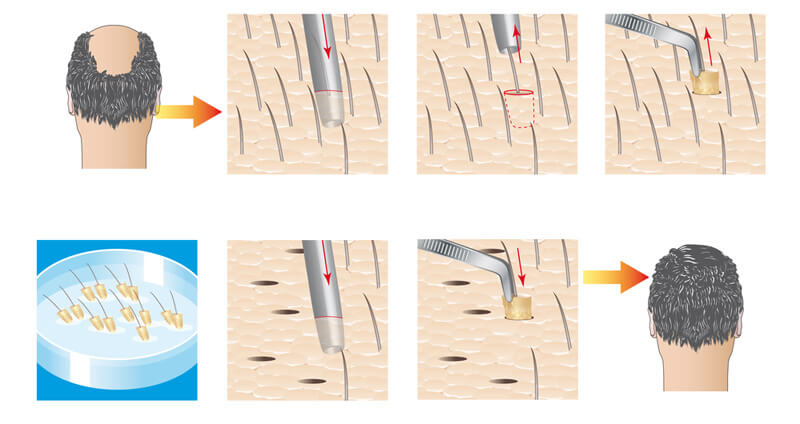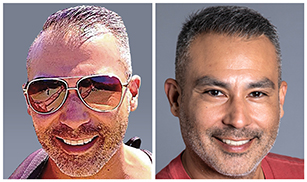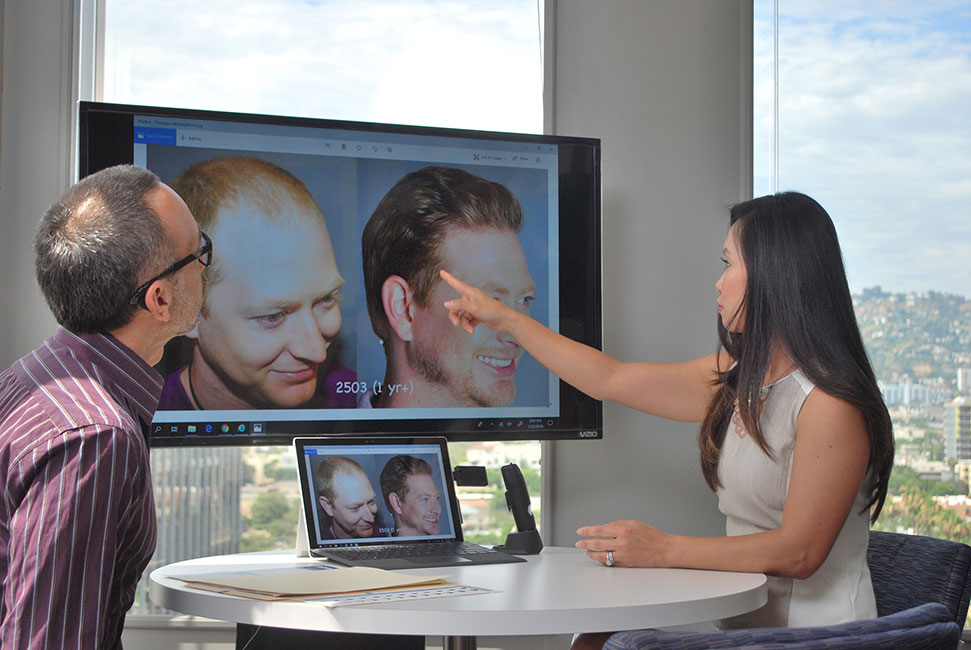Hair Transplant Cost & Financing
Get a Free
Information Kit
Hair Transplant: A Complete Breakdown of Costs For 2021
Hair transplants are a popular hair treatment method, but they’re also one of the most expensive. As a result, many men who would like to get a transplant cannot afford to do so. This article will discuss:
- the cost of transplants
- factors that contribute, such as location and method.
- who qualifies for a transplant
- risks involved
- some lower-cost yet effective alternatives to a hair transplant.
What Is a Hair Transplant?
A hair transplant is a surgical procedure for hair restoration (1). It involves the removal of hair from one area of the scalp (the donor site) and transplantation onto another (the recipient site).
The donor site is typically in the back of the head. This area of the scalp is immune to hair loss, and the extracted follicles can survive in their new location for many years or even decades.
The procedure is performed by a hair restoration surgeon with the help of several technicians. Transplants are one of the most well-known hair loss treatments on the market.

Though it can restore what looks like a nearly full head of hair, a hair transplant isn’t actually a cure. Instead, it’s a technique that aims to cover up balding and thinning patches.
What Are the Types of Hair Transplant Methods?
FUT and FUE are the most commonly used methods today (more on that below). There also used to be other methods that are now outdated. The most famous of these was the punch graft.
Punch Graft
Using a 4mm ‘punch’, the surgeon removes a cylinder of hair-bearing skin from the donor site. This cylinder typically contains 12 – 30 individual strands of hair. The surgeon then carefully places them back into the recipient site.
The punch graft was the most popular method of transplantation for over 20 years. However, it gave unnatural and ‘pluggy’ looking results. This is where the term ‘hair plug’ originates.
Recommended for You




Almost no surgeon uses this method nowadays.
Follicular Unit Transplantation (FUT)
Follicular Unit Transplantation (FUT) is a more modern method of hair transplant.
In this method, the surgeon removes a strip of hair a few centimeters in length from the donor area. The site is then sutured.
Next, the strip is placed under a microscope. The surgeon then works to extract individual follicular units from the graft, and places these individual units into the recipient area.
It is useful to explain at this point what follicular units are. Though this is not visible to the naked eye, hairs on our scalp don’t grow individually. Instead, they typically grow in groups of 2 or 3 linked hairs. These are the so-called follicular unit (2).
Extracting and transplanting individual follicular units gives better cosmetic results compared to blindly transplanting entire patches of skin, like the old punch graft method. The transplanted hair looks smooth and natural.
For this reason, FUT is widely considered a revolution in hair transplantation technology.
Follicular Unit Extraction (FUE)
Alongside FUT, Follicular Unit Extraction (FUE) is another modern hair transplant method (3). However, FUE offers many more benefits. These include minimized scarring and quicker recovery.
With FUE, the surgeon transplants individual follicular units into the recipient area, just as in FUT. The difference is in how he removes them from the back of the head. Instead of removing a strip of hair-bearing skin, the surgeon removes them one by one.
This takes considerable time, which contributes to a higher cost. The upside is the lack of a visible scar in the donor area.

Who Is a Candidate?
The surgeon will ultimately determine who is a suitable candidate for a transplant. Here are some general guidelines to give you an idea of who qualifies.
Men With Norwood Stage 3 Hair Loss and Above
If you’ve been diagnosed with Male-Pattern Baldness (MPB), you are probably familiar with the Norwood scale for hair loss. In short, it’s a diagnostic scale used to determine how far MPB has progressed:

While hair loss caused by MPB does begin to become noticeable during Norwood 2, many surgeons will only perform a transplant on patients diagnosed with Norwood 3 and above.
Men With Stable Hair Loss
In addition to a Norwood 3 diagnosis, hair transplants are best performed on men with stable hair loss. But what does this mean?
Hair transplant are a purely cosmetic intervention. By shuffling around the remaining healthy hair follicles, they merely restore the illusion of fullness (2). By itself, a hair transplant cannot add a single new healthy hair follicle.
This means that if you are still in the process of actively balding, you are likely to need a second hair transplant in a few years. The doctor will remove more healthy hairs from the donor areas and plant them into the newly thinned areas.
Since each hair transplant is an invasive surgical transplant, you want to have the smallest possible number of transplants. Ideally, you would like to get away with just one. This can only happen if you have stabilized your hair loss, either naturally or through some treatment.
How Much Does a Hair Transplant Cost?
Keep in mind, costs will vary. However, we can get a general idea by looking to real transplant patients for their own experience.
According to various clinic websites and reviews from real transplant patients, here’s a basic breakdown by location:
- London, UK: between $5000-$10000
- Vancouver, Canada: $12000-$20000
- Bangalore, India: $2000-$5000
- New York, USA: $5000-$20000
- Instanbul, Turkey: $2000-$4000
Where exactly you will fall in these ranges depends primarily on the type and extent of your hair loss.
To get the best idea of cost, we recommend you consult with at least three hair restoration surgeons in your area.
Why Do the Costs Vary?
The cost of a transplant will depend on many factors. These include:
- Geographic location is perhaps the most important factor. We saw above how the same procedure can be many times more or less expensive from one part of the world to the next.
- Extent of of balding. This is the second most important factor. The more extensive the hair loss, the more grafts (follicular units) you will require. Most clinicals charge by the graft, meaning the more severe your hair loss, the more costly. The cost does not increase linearly. The more grafts you transplant, the lower the average cost per graft will tend to be. For example, 3000 grafts will cost less than twice the cost of 1500 grafts.
- The particular surgeon or clinic. Like any other service, all surgeons and clinics are not created equal. This will be reflected in the prices they charge.
- The type of procedure, namely FUE vs FUT. FUE is often slightly more expensive, though this is not absolute.
Why Is It So Expensive?
While a transplant may seem expensive, you have to consider the complexity of the procedure.
A properly qualified surgeon must perform either FUE or FUT. For this he will require the assistance of several highly trained technicians.
The procedure takes place in modern clinics, using very expensive equipment.
Depending on the extent of hair loss, a FUT session can take anywhere from 5 – 7 hours for one session. FUE can last even longer. Sometimes even an entire day will not be enough. In this case, the procedure will take place over several days.
Add on top of that the admin overhead, the cost of insurance, and advertising, and the price tag begins to make sense.
Costs After the Surgery
The costs don’t stop with the surgery. Immediately afterward, you are likely to require certain medications to deal with the adverse events from the surgery. These might include painkillers, anti-inflammatories, and antibiotics to prevent infection.
Hair transplant is an outpatient procedure, meaning you can generally go home the same day.
In some cases, and depending on your line of work, your surgeon might instruct you to take a few days off. This possibility of lost income is another consideration to factor in when determining the overall cost.
Is It Worth It?
The answer to this question is, “it depends”.
For many men with thinning and recession, a hair transplant can be the right answer. A transplant can restore the appearance of healthy hair like no other intervention, and it can achieve this in the shortest amount of time. The psychological benefits of this can be significant, including more confidence and higher self-esteem.
However, there are risks with this procedure. There is also the possibility you might not select the best clinic or method for your particular hair loss. This can be especially true if you choose to have the procedure abroad, in a low-cost country.
A good surgeon will help you weigh the risks and benefits and determine if the procedure is right for you. The surgeon will also advise of your odds of success with the procedure.
Are There Less Expensive Treatment Options?
Many men simply cannot afford a transplant. For them these are a number of other options available.
Low-Light Laser Therapy (LLLT)
Low-Light Laser Therapy (LLLT) is a treatment that uses lasers to target areas of hair shedding (4). This procedure can be performed by a dermatologist in-office, or at home with laser combs or helmets.

LLLT works in a number of ways. It can:
- Stimulate anagen phase in telogen phase hairs
- Prolong the duration of anagen
- Increase hair growth rates in anagen phase follicles
- Prevent premature catagen phase development
These results are believed to be caused by the laser’s interaction with the hair follicles’ cells and (possibly) stimulation of the mitochondria.
Cost
Depending on whether you plan to seek out professional treatment or perform LLLT at home, costs will vary.
The cost of an LLLT comb or helmet ranges from $200 – $1,000. You can find devices for less, but they will be of lower quality.
In-office procedure costs will vary as well. For most, LLLT is an on-going treatment that’s completed over a number of sessions. As such, your costs can range from the mid-hundreds to a few thousand dollars.
Microneedling

A treatment procedure that’s practiced as often at home as it is in-office, microneedling uses tiny needles to create micro wounds in the scalp (5). These wounds then go through a three-step process as they heal:
- Inflammation
- Proliferation
- Maturation (Remodeling)
While injuring the scalp may seem counterintuitive to hair growth, the process actually stimulates the production of collagen, as well as new skin cells. These new cells can then generate healthy new hair strands.
Cost
As with LLLT, you can perform microneedling at home or in-office. This means the cost will vary widely.
You can purchase one of the cheapest microneedling tools, the dermaroller, for about $25. However, more advanced tools that are electrically powered can cost anywhere from $30 to a few hundred dollars.
In-office microneedling by a dermatologist can cost a few hundred dollars.
Many men choose to have one microneedling session at a specialist’s office. This gives them an idea of the correct procedure and how their skin reacts. They then continue treatment at home. This is possible because microneedling is a relatively simple procedure. The instruments are also affordable.
Platelet-Rich Plasma (PRP)
Just like LLLT, Platelet-Rich Plasma (PRP) therapy is still in its earlier stages of development. However, recent scientific studies have shown it to be a promising option for people with significant shedding and thinning (6).
PRP involves the removal of blood from a patient’s body. The blood is then separated (using a centrifuge) into plasma and red blood cells. The plasma is extracted, and then injected directly into areas of hair loss.
This works surprisingly well, and here’s why:
Plasma is a blood product that contains numerous growth factors. These include Platelet-Derived Growth Factor (PDGF), Epidermal Growth Factor (EGF), and Insulin-Like Growth Factor (IGF).
These growth factors induce the proliferation of dermal papilla cells, which means more hair can then be produced in the area.
Cost
PRP – the only treatment in our alternatives list that cannot be performed at home – is also one of the more expensive options. However, it’s very likely that the cost of PRP will still be lower than that of a hair transplant.
According to real PRP patients on RealSelf, the average cost across various locations is $1,725 (ranging from $350 – $3,100). However, with a ‘worth it’ rating of 74%, it may be something you want to consider.
What are the Possible Side-Effects of Hair Transplants?
Hair transplants are an increasingly common choice for those suffering from thinning and receding hair.
According to census results produced by the International Society of Hair Restoration Surgery (ISHRS), the number of annual hair transplants conducted in the United States increased from 100,455 to 112,409 between 2006 and 2014.
In the same time period, the number of hair transplants conducted throughout the world rose 225,799 to 397,048, with the Asian market, in particular, experiencing a twofold increase in adoption of the practice.
Even though hair transplants have become common procedures, they are still a type of invasive surgery and have the risk for potential side effects.
The side-effects of hair transplants vary from patient to patient. Some may experience relatively trouble-free transplant procedures, whereas others experience one or a combination of the following side-effects. Proper preparation before the transplant is crucial.
Similarly, you must follow the surgeon’s instructions after the transplant in order to avoid post-operative complications. For example, your surgeon might instruct you to avoid scented shampoos, as well as avoid wearing hats or combing/brushing your hair for the first few weeks.
Here are the most common 10 side effects from a hair transplant (7):
1) Post-Surgical Edema
A common side-effect of many types of surgery, post-surgical edema is essentially the build-up of fluid that causes swelling following surgery.
Researchers currently understand little about the causes of post-surgical edema in hair transplant patients. However, according to a 2014 study published in the International Journal of Trichology, it occurs in 42.47 percent of hair transplant patients (7).

The study examined the complications of hair transplants in 73 patients.
Generally, the post-surgical edema resolves on its own after a few days.
Learn about non-surgical hair restoration here or about restoring the hairline in particular here.
2) Hemorrhage
The same 2014 study discovered that 1.37 percent of respondents reported heavy bleeding during the procedure. This uncommon side-effect is often due to inexperience or a mistake on the part of the surgeon.
3) Sterile Folliculitis
Returning to the previously mentioned 2014 study, sterile folliculitis is also a common side-effect of the hair transplant procedure.

Typically characterized as a sort of rash or scarring in the transplanted area, it can make the transplant feel very uncomfortable, causing itchiness in addition to altering cosmetic appearance.
According to the International Journal of Trichology study, sterile folliculitis affected 23.29 percent of patients.
4) Hair Thinning
In many cases, the donor area will also be affected by the procedure. Hair thinning in such areas is common, which may cause concern for patients who are wary of losing hair in one area of the body just to remedy hair loss in another.

However, in the majority of cases, this thinning in the hair removal area lasts for a brief period of time before the natural thickness of hair growth resumes.
5) Lichen Planopilaris (LPP)
Essentially a more extreme version of Sterile Folliculitis, Lichen Planopilaris (LLP) is an inflammatory hair disorder. It results in excessive scar tissue forming in the transplanted area.
According to a 2012 study into the condition published in the British Journal of Dermatology, LLP can also lead to alopecia, thus causing more hair thinning (8).
However, the study concluded that LLP is a very uncommon side-effect of the transplant procedure. It notes that the study only uncovered seven patients who experienced LLP following a hair transplant. None of them had any history of LLP prior to undergoing surgery.
6) Itchiness
As the hair transplant procedure involves creating tiny wounds in the scalp in order to implant hair, scabbing will occur across hundreds, or potentially thousands, of hair follicles.

This results in itchiness in the transplanted area. Patients should avoid scratching, as doing so can remove the scabs and delay the healing process. Daily washing of the hair using non-perfumed shampoos can help alleviate the itching.
7) Numbness
Returning to the 2014 study published in the International Journal of Trichology, approximately 10 percent of patients will experience numbness in the aftermath of hair transplant surgery (7).
This can last for a number of weeks following the surgery but it is usually a temporary side-effect that fades over time as the body adjusts to the transplant.
8) Hiccups
Hiccups are a less common side-effect. They affect approximately 4% of hair transplant patients. According to US Hair Restoration, the cause of hiccups may be due to local irritation of nerve endings caused by the surgery.
In particular, irritations to the posterior auricular and branches of the cervical plexus can result in hiccups. Further, some medications provided to patients post-surgery, such as steroids, are associated with hiccupping.
9) Cysts
Typically appearing in the recipient area following extensive transplant activity, cysts can vary in size and will often be purple in color. Happily, these cysts are usually benign and will disappear after two or three weeks.
10) Additional Concerns: Scarring
The donor area used in the FUT transplant process will sometimes leave a wide or raised scar. While raised scars are fairly uncommon, wide scars are reported in approximately 15 percent of patients.

Typically, surrounding hair can be used to cover the appearance of the scar. Despite this, it can still cause cosmetic damage and, in some cases, prevent hair growth in the donor area. Further, the scar may prevent hair transplant patients from wearing short hairstyles, such as crew cuts.
Go here to learn about the typical timeline for a hair transplant.
Who Should Avoid Hair Transplants?
Hair transplants are a generally safe procedure, and most side-effects are temporary. However, there are some people who should avoid hair transplants altogether. These include:
- Those who don’t have a sufficient reserve of hair in the donor area. These will usually be men who have already undergone multiple transplants in the past.
- Women who have diffuse hair loss across the scalp.
- Those who are undergoing certain medical treatments
- People with different types of hair loss (non-AGA), for example Alopecia Areata or Telogen Effluvium
Your surgeon will thoroughly assess your type of hair loss and medical history to determine if you are a suitable candidate.
Conclusion
If a hair transplant is your treatment of choice, keep in mind that costs will vary. Having said that, it is the most expensive option on the market, and you may find that the costs don’t justify the benefits.
There are many others methods to choose from, including the alternatives discussed above. The choice you make is personal, and depends on your unique circumstances. These include among others the severity of your hair loss, the psychological impact it is having on you, and your budget.
As with any hair loss treatment, if you are considering a hair transplant, make sure to speak to a qualified medical professional.
Also, I would recommend reading our guide to hairline restoration if you have early-stage hair loss.
Hair Transplant Cost & Financing
Learn more about our free personalized estimate and our many financing and payment options available.

Actual Bosley Patient.
Individual results may vary.

Before After
How Much Does a Hair Transplant Cost?
The cost of a hair transplant varies from person to person, so we are not able to provide an exact estimate online or over the phone. If you’re interested in a hair transplantation procedure, we recommend that you visit Bosley for a free video or in-person consultation.
Not only will our physicians and counselors be able to provide you with an estimate, but they can review monthly payment plan options to help make your procedure affordable on practically any budget.
Actual Bosley Patient.
Individual results may vary.
Per-Graft: How We Determine Cost
Bosley calculates the final price of each hair transplant procedure on a per-graft basis, so the costs are unique to each patient. The exact number of grafts you’ll need (procedure size) depends on the extent of your hair loss and your hair restoration goals. The average cost of a Bosley hair transplantation is approximately $10,000, but the price can range between $8,000 and $18,000 depending on procedure size.
The best way to get an accurate cost estimate is to have a free consultation.
The True Value of Bosley Hair Restoration
While the low upfront cost of temporary cosmetic solutions can seem like a good deal, the cost of maintaining cosmetic solutions ends up being significantly more than a Bosley procedure. Our transplanted hair restorations are permanent. Bosley hair transplantations are performed by the foremost experts in the field, so you can feel confident in their ability to deliver a lasting solution well worth the cost.
Actual Bosley Patient. Individual results may vary.
Financing Your Hair Transplant
Even if you want a hair transplant, we understand that the upfront cost can be more than some can afford out of pocket, which is why we offer multiple third-party financing options that work with practically any budget.* Get your procedure now, and pay it off in monthly installments. During your free consultation, a Bosley counselor can help you find the payment plan and terms that suit your budget. Start your credit application below.
Actual Bosley Patient. Individual results may vary.
Get Your Estimate
Only a Bosley-affiliated physician can assess your hair loss classification and growth pattern in order to determine how many hair grafts are needed to achieve your desired results.
If you’re ready to permanently restore your hair, schedule a free, no-obligation consultation to get a cost estimate and find out if a Bosley hair transplantation is right for you.
You Might Also Want to Know
Hair Transplant Recovery and Timeline: What to Expect
The Connection Between Stress & Hair Loss: What You Should Know
Hair Loss Diet: 5 Foods that Promote Healthy Hair
*Subject to credit approval. Minimum monthly payments required. See provider for details. All figures are estimates. Actual monthly payments will vary from lender to lender based upon the amount financed, the terms for which you apply, and your credit standing. Rates for various lenders’ programs range from 3.99% to 28.99%. Additional terms and conditions may apply depending on the lender selected. All information subject to change without notice.
Financing is provided by independent finance lenders, and the lenders independently approve the financing and its terms and conditions. Bosley does not receive any compensation upon the submission or lender’s independent approval of an application. Submission of an application does not obligate you to use the lender to finance a procedure and no amounts are charged until you agree to undergo a procedure. A Bosley physician must confirm that you are a candidate for surgical hair restoration.

Looking for Answers?
Everyone’s situation is unique. Our hair restoration specialists are ready to answer all of your questions. Let us help you determine the right solution for you.
Get a Free
Information Kit
Still researching? Get our free information kit and $250 Gift Card.
Hair Transplants: What to Expect
Like good health and youth, most of us take our locks for granted — that is, until they’re gone. For many people, a hair transplant can help bring back what looks like a full — or at least a fuller — head of hair.
If thinning up top or going bald really bothers you, the procedure can be one way to feel more confident about your looks. But first talk with your doctor about what you can expect during and after the surgery.
What Is a Hair Transplant?
It’s a type of surgery that moves hair you already have to fill an area with thin or no hair. Doctors have been doing these transplants in the U.S. since the 1950s, but techniques have changed a lot in recent years.
You usually have the procedure in the doctor’s office. First, the surgeon cleans your scalp and injects medicine to numb the back of your head. Your doctor will choose one of two methods for the transplant: follicular unit strip surgery (FUSS) or follicular unit extraction (FUE).
With FUSS, the surgeon removes a 6- to 10-inch strip of skin from the back of your head. They set it aside and sews the scalp closed. This area is immediately hidden by the hair around it.
Next, the surgeon’s team divides the strip of removed scalp into 500 to 2,000 tiny grafts, each with an individual hair or just a few hairs. The number and type of graft you get depends on your hair type, quality, color, and the size of the area where you’re getting the transplant.
If you’re getting the FUE procedure, the surgeon’s team will shave the back of your scalp. Then, the doctor will remove hair follicles one by one from there. The area heals with small dots, which your existing hair will cover.
After that point, both procedures are the same. After they prepare the grafts, the surgeon cleans and numbs the area where the hair will go, creates holes or slits with a scalpel or needle, and delicately places each graft in one of the holes. They’ll probably get help from other team members to plant the grafts, too.
Depending on the size of the transplant you’re getting, the process will take about 4 to 8 hours. You might need another procedure later on if you continue to lose hair or decide you want thicker hair.
Expectations and Recovery
After the surgery, your scalp may be very tender. You may need to take pain medications for several days. Your surgeon will have you wear bandages over your scalp for at least a day or two. They may also prescribe an antibiotic or an anti-inflammatory drug for you to take for several days. Most people are able to return to work 2 to 5 days after the operation.
Within 2 to 3 weeks after surgery, the transplanted hair will fall out, but you should start to notice new growth within a few months. Most people will see 60% of new hair growth after 6 to 9 months. Some surgeons prescribe the hair-growing drug minoxidil (Rogaine) to improve hair growth after transplantation, but it’s not clear how well it works.
Risks and Costs of Treatment
The price of a hair transplant will depend largely on the amount of hair you’re moving, but it generally ranges from $4,000 to $15,000. Most insurance plans don’t cover it.
As with any kind of surgery, transplants have some risks, including bleeding and infection. There’s also the chance for scarring and unnatural-looking new hair growth.
Around the time new locks start to grow, some people have inflammation or an infection of the hair follicles, called folliculitis. Antibiotics and compresses can relieve the problem. It’s also possible to suddenly lose some of the original hair in the area where you got the new strands, called shock loss. But most of the time, it’s not permanent.
Talk with your doctor about these risks and how much improvement you’re likely to get from the surgery. They can help you decide if it’s a good option for you.
Show Sources
Photo Credit (inset): BSIP / Medical Images
Harvard Health Publications, Harvard Medical School: “Treating Female Pattern Hair Loss.”
MedlinePlus.gov: “Hair Transplant.”
Dermatologic Surgery at the University of Washington: “Hair Transplantation.”
Cleveland Clinic – Photo Caption
Medcial Images – Photo Caption






